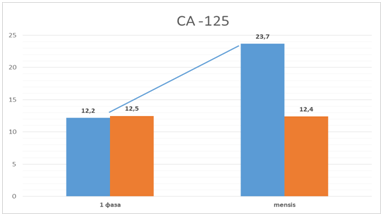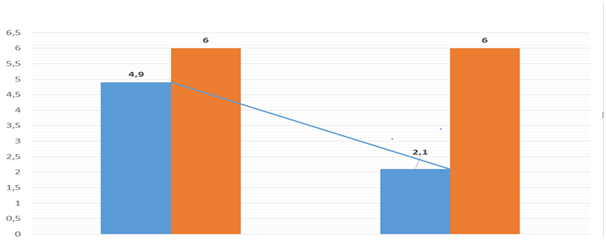Journal of
eISSN: 2373-4426


Mini Review Volume 9 Issue 6
1Department of Obstetrics and Gynecology of KRSU, Kyrgyzstan
2Department of Obstetrics and Gynecology KSMA, Kyrgyzstan
Correspondence: Askerov AA, professor of the Department of Obstetrics and Gynecology of KRSU, Kyrgyzstan
Received: November 13, 2019 | Published: December 3, 2019
Citation: Askerov AA, Satybaldieva AJ. Non-invasive research in ovarian endometriosis. J Pediatr Neonatal Care. 2019;9(6):165-166. DOI: 10.15406/jpnc.2019.09.00400
The article presents the results of a study on noninvasive early diagnosis of the endometriosis ovarian cyst via ultrasound and on-markers CA-125. The effectiveness of using antimulyler hormone in predicting the reserve capacity of the ovary after surgical treatment of endometriosis cyst.
Keywords: endometriosis, cyst, ovary, oncomarkers, hormone, surgical treatment
Most often with endometriosis, the so-called chronic pain syndrome in the pelvic region is noted. For the early diagnosis of endometriosis, along with the analysis of clinical data, using ultrasound, endoscopic and magnetic resonance studies, a method for identifying tumor antigens is very promising.1‒3 Therefore, the tumor antigen CA-125 is currently the method of choice in the diagnosis of endometriosis. Diagnosis of endometriosis using this test without a full range of laboratory and instrumental studies is not legitimate. The aim of the work was to study in women with endometriotic ovarian cysts the method of early non-invasive diagnosis through tumor markers CA-125 and the assessment of the ovarian reserve after treatment with antimuller hormone.
Under our supervision, there were 47 women of reproductive age with signs of endometriotic ovarian cysts diagnosed within 1-2 months after visiting a gynecologist. Each patient underwent an analysis of development factors in comparison with healthy ones. For a comprehensive clinical and laboratory diagnosis of endometriotic ovarian cysts, ultrasound, quantitative analyzes for tumor markers CA-125 and for antimuller hormone were used. At the same time, the study in the blood of SA-125 tumor markers was carried out in the follicular phase and on the days of menstruation for early diagnosis of ovarian endometriosis with subsequent verification by ultrasound, and the determination of the anti-Mühller hormone to assess the ovular reserve was performed before and after surgical treatment on the ovary.
The age of women ranged from 21 to 27 years. In a prospective study, we managed in 41 women with endometriotic ovarian cysts to diagnose twice the oncomarkers of CA-125 (in the 1st phase and during menstruation), and twice the measurement of the antimuller hormone before and after surgical treatment. The ratio of indicators of the level of CA-125 during menstruation to the indicator during the follicular phase of the cycle exceeded 1.5 times the average normal values, which indicated the presence of endometriosis during ultrasound verification (Figure 1). It should be noted that among 41 patients in 9 (22.4%) patients, the endometriotic cyst was not verified by ultrasound due to the small shape (diameter less than 2.5-3cm). In outpatient practice, a gynecologist faces a difficult question regarding the routing and management tactics of such patients, especially if there is an acute issue of pregnancy. The surgical approach for endometriotic ovarian cysts is generally consistent with that for any benign ovarian tumor. In the treatment of our patients of reproductive age, the most important was the preservation of fertility. At the same time, all the principles of microsurgical surgery were not always observed in all hospitals using the gentle effects of modern surgical energies on the ovarian tissue (enucleation of only the affected areas) to maximize the preservation of the ovarian reserve.

Figure 1 Diagnostic comparative increase in patients with ovarian endometriosis of the tumor marker CA-125.

Figure 2 Dynamics of AMH level in patients with ovarian endometriosis before and after surgical treatment.
The scope of the operation must have been designed to reduce the risk of relapse. Our research data showed a significant decrease in serum concentration of AMH (anti-Müller hormone) after surgical removal of the endometrioma compared to average values (Figure 2).
It was shown that surgical treatment of ovarian endometrioma is accompanied by a decrease in serum AMH level by 2.36 times. Thus, the results of the study indicate the negative impact of surgical removal of ovarian endometrioma on ovarian reserve in women of reproductive age. In our study, an AMG study was conducted in 47 patients after surgical treatment, in which a low mean level of 2.1+-1.5ng\l was determined.
None.
The authors declared there is no conflict of interest.
None.

©2019 Askerov, et al. This is an open access article distributed under the terms of the, which permits unrestricted use, distribution, and build upon your work non-commercially.